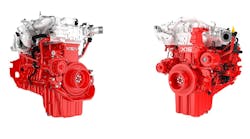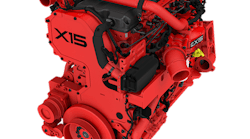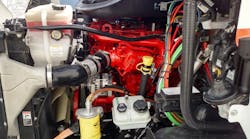 According to Cummins, its overall design philosophy is to develop a range of technical solutions to meet the varying needs of engine customers, then to choose those techniques most app Walt Moore, Senior Editor According to Cummins, its overall design philosophy is to develop a range of technical solutions to meet the varying needs of engine customers, then to choose those techniques most appropriate for the application. High-pressure, common-rail fuel system (depicted here) may be part of the solution in some instances. Chemical modeling allows engineers to investigate the combustion process resulting from various "combustion recipes." Tier-3 engines must attain nearly a 40-percent reduction in NO x , compared to Tier-2 models.On a recent visit to the Cummins Technical Center in Columbus, Ind., we looked over the shoulder of an engineer as he ran a computer-animation sequence depicting the formation of particulate matter (PM) and nitrogen oxides (NO x) as the fuel-flame propagated in a diesel engine's combustion chamber. He was searching for the optimum "combustion recipe," that is, the combination of design parameters that would most effectively control emissions without compromising performance. This design technique, he said, allows engine-development time to be greatly condensed, yet allows investigating a vast number of design permutations.
Cummins calls its approach to engine development "analysis-led design," and by using the technique to evaluate the combustion process, engineers can model chemical reactions anywhere in the cylinder, at any point in time. The technique is said to allow the engineer to modify critical parameters—including fuel delivery, air management, electronic control and physical design of combustion-chamber components—then to quickly evaluate their overall effect. The process allows investigating literally thousands of such combinations before committing to a particular design.
Cummins is applying this engineering approach as it develops off-road engines that will comply with the Environmental Protection Agency's Tier-3 emissions standards and with Europe's Stage IIIA standards. The bottom line of this effort, says Cummins, is that its engines will meet these standards with "in-cylinder" technology that requires no external emissions components, meaning no exhaust after-treatment, no exhaust-gas recirculation, and no variable-geometry turbochargers.
Although certain Tier-3/Stage IIIA engine models will be fitted with high-pressure, common-rail fuel systems, the exterior design envelope of these engines remains essentially the same as that for predecessor models. Thus, says Cummins, the Original Equipment Manufacturer (OEM) can install engines complying with Tier-3/Stage IIIA regulations with virtually no modification of present-machine designs. In addition, the techniques used to meet the latest regulations, due for certain horsepower ranges in January 2005, are tolerant of high-sulfur fuel used in off-road engines. (Sulfur will fall to 500 ppm in 2007, then to 15 ppm in 2010.)
Latest in Diesel Engines, Over 250 hp
| |





